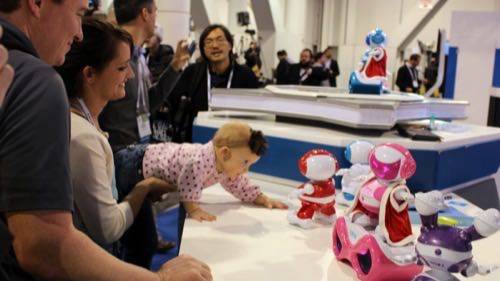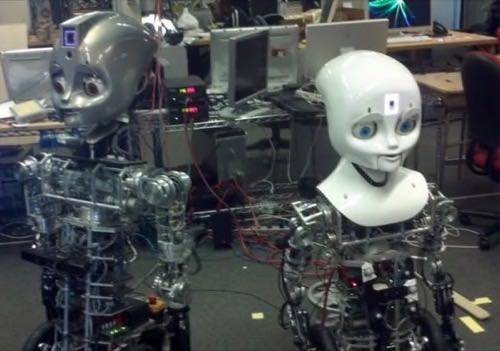Guest author Anne Balduzzi is the founder and CMO of SameGrain, a “privacy first” social discovery platform, and an early pioneer of the Internet, with marketing and product development roles at Apple, Quantum Computer Services (later renamed AOL) and Viewtron.
Ray Kurzweil popularized the Terminator-like moment he called the “singularity,” when artificial intelligence (AI) overtakes human thinking. With all the advancements that have been made within the robotics industry and artificial intelligence, are we finally at the cusp of this reality?
From robotics to microbots to machine-learning software, the growth of these technologies is surging. According to a report from Business Insider Intelligence, there will be a $1.5 billion market for consumer and business robots by 2019. Furthermore, a report by Transparency Market Research states that the market for predictive analytics software will amount to more than $6.5 billion worldwide in 2019.
See also: This Robotic Odd Couple May Soon Run A Warehouse Near You
As these advances shift from the traditional industrial and logistical application to a new focus on consumer and office use, their potential to drastically alter everyday life increases.
Robotic and AI technologies have advanced so rapidly, a “Hollywood-like world,” with a substantial robot population, may not seem that far away. Sure, these mechanized technologies can serve us drinks, answer Jeopardy questions and connect us with people across the globe. But despite Elon Musk’s concerns about AI leading to robots that will us, the reality is that a robot civilization simply cannot exist without humans.
The Present: Improving Human Life With Robotics And AI

When it comes to the robotics and artificial intelligence industry, there are several broad roles that these technologies fill. The first is physical integration, where processes can be vastly improved through robotics.
See also: What It Took These Four Women To Get Into Robotics
Notably, the impact of this integration can be seen in science and medicine, with robotics opening the door for new innovation and exploration. Now, not only can we explore previously inaccessible areas from the human body to outer space, but doctors can harness the power and precision of robotics in medical procedures, reducing the risk of human error.
The latter involves machine-learning technologies. New cognitive applications tap into human behaviors or tendencies, and use correlative data for specific purposes. Systems can gather tons of specific information on individuals that is then used to provide a personalized experience—from the best travel route home and shopping recommendations, to even finding romantic or professional connections.
Companies and advertisers are leveraging this predictive technology to learn more about customers and successfully forecasting future purchasing behaviors.
Realistic Future: The Best Case Scenario For Robotics And AI
We can ponder a sci-fi-like future steeped in AI and robotic systems, but perhaps more realistically, the future hinges on where a variety of physical applications meet machine learning. Take wearable devices, for instance.
See also: Something About ‘Her’: Will Our Computers Ever Be Real Friends?
Wearable devices, like the Apple Watch, allow us to manage our personal and business lives conveniently from a chic timepiece. But beyond that, they also serve as health management solutions and productivity calculators using machine learning. Wellness apps like Health from Apple are tapping into our daily diets and helping us keep track of exercise routines. Productivity apps like Hours track our time and allow us to easily jump from task to task.
One day, those gadgets could usurp the role of professionals like dietitians or project managers. But could they ever be smarter than the human counterparts they may some day replace?

The answer, very likely, is no. Emotional Intelligence (EI) and the basic understanding of human nature and social interactions is what distinguishes man and machine. Without the scientists, engineers and end users who set the parameters and provide input data, computers and machines can’t get “smarter.” People who use smartphones, Facebook accounts or even simple Google searches feed the machine-learning beast with every keystroke.
See also: Now You Can Build Your Robots Using A Snapdragon Processor
Every interaction an individual takes may lead to more powerful artificial intelligence systems, but AI still cannot exist without human intervention.
Kurzweil and Musk have made bold predictions on what the future of robotics and artificial intelligence might look like. Only time will tell if human cyborgs will truly exist. In the near future, we can be certain that robotics and smart technologies will infiltrate our lives from the workplace to our home in surprising ways. Imagine your phone ordering food at a restaurant based on your personal nutritional needs.
With continued human interaction and development of these technologies our lives will be “smarter,” but we are nowhere near a world where robots replace humans entirely. After all, a robot-bartender may be able to make you the perfect mixed drink, but it cannot listen to your problems and empathize.
Photos courtesy of Shutterstock; Adriana Lee for ReadWrite; MIT

















